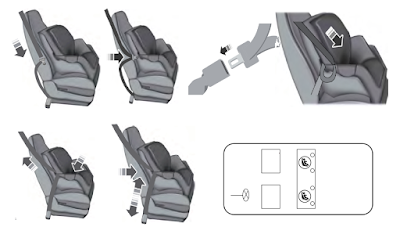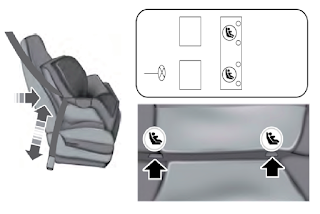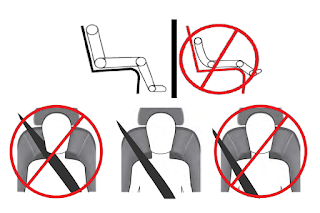Ford Escape Guide : How to Install Child Seats
Child safety restraints must be bought separately from your vehicle. Failure to follow these Ford Escape instructions and guidelines may result in an increased risk of serious injury or death to your child. All children are shaped differently. The National Highway Traffic Safety Administration and other safety organizations, base their recommendations for child restraints on probable child height, age and weight thresholds, or on the minimum requirements of the law. We recommend that you check with a NHTSA Certified Child Passenger Safety.Ford Escape Guide
Technician (CPST) to make sure that you properly install the child restraint in your Ford Escape vehicle and that you consult your pediatrician to make sure you have a child restraint appropriate for your child. Failure to properly restrain children in child restraints made especially for their height, age and weight, may result in an increased risk of serious injury or death to your child.
Child Seats Guide
Use a child safety seat (sometimes called an infant carrier, convertible seat, or toddler seat) for infants, toddlers, or children weighing 40 pounds (18 kilograms) or less (generally age four or younger). Using Lap and Shoulder Belts
On summer days, the temperature inside the vehicle can rise very quickly. Exposure of people or animals to these high temperatures for even a short time can cause death or serious heat related injuries, including brain damage. Small children are particularly at risk.
Child Seats Tips
Airbags can kill or injure a child in a child seat. So, here's our Child Seats Tips:
- Never place a rear-facing child seat in front of an active airbag.
- If you must use a forward-facing child seat in the front seat, move the seat upon which the child seat is installed all the way back.
- Children 12 and under should be properly restrained in the rear seat whenever possible.
- Depending on where you secure a child restraint, and depending on the child restraint design, you may block access to certain safety belt buckle assemblies and LATCH lower anchors, rendering those features potentially unusable.
- To avoid risk of injury, occupants should only use seating positions where they are able to be properly restrained.
When installing a child safety seat with combination lap and shoulder belts:
- Use the correct safety belt buckle for that seating position.
- Insert the belt tongue into the proper buckle until you hear a snap and feel it latch. Make sure the tongue is securely fastened in the buckle.
- Keep the buckle release button pointing up and away from the safety seat, with the tongue between the child seat and the release button, to prevent accidental unbuckling.
- Place the vehicle seat upon which the child seat will be installed in the upright position.
- Put the safety belt in the automatic locking mode. See Step 5. This Ford vehicle does not require the use of a locking clip.
Perform the following Child Seat tutorial instruction guide steps when installing the child seat with combination lap and shoulder belts, although the child seat illustrated is a forward facing child seat, the steps are the same for installing a rear facing child seat. Ford Escape Tutorial Installing Child Seat:
- Position the child safety seat in a seat with a combination lap and shoulder belt.
- Pull down on the shoulder belt and then grasp the shoulder belt and lap belt together.
- While holding the shoulder and lap belt portions together, route the tongue through the child seat according to the child seat manufacturer's instructions. Be sure the belt webbing is not twisted.
- Insert the belt tongue into the proper buckle (the buckle closest to the direction the tongue is coming from) for that seating position until you hear a snap and feel the latch engage. Make sure the tongue is latched securely by pulling on it.
- To put the retractor in the automatic locking mode, grasp the shoulder portion of the belt and pull downward until all of the belt is pulled out. The automatic locking mode is available on the front passenger and rear seats.
- Allow the belt to retract to remove slack. The belt will click as it retracts to indicate it is in the automatic locking mode.
- Try to pull the belt out of the retractor to make sure the retractor is in the automatic locking mode (you should not be able to pull more belt out). If the retractor is not locked, unbuckle the belt and repeat Steps 5 and 6.
- Remove remaining slack from the belt. Force the seat down with extra weight, for example, by pressing down or kneeling on the child restraint while pulling up on the shoulder belt in order to force slack from the belt. This is necessary to remove the remaining slack that will exist once the extra weight of the child is added to the child restraint. It also helps to achieve the proper snugness of the child seat to your vehicle. Sometimes, a slight lean toward the buckle will additionally help to remove remaining slack from the belt.
- Attach the tether child strap (if the child seat is equipped).
- Before placing the child in the seat, forcibly move the seat forward and back to make sure the seat is securely held in place.
- To check this, grab the seat at the belt path and attempt to move it side to side and forward and back. There should be no more than 1 inch (2.5 centimeters) of movement for proper installation.
We recommend checking with a NHTSA Certified Child Passenger Safety Technician to make certain the child restraint is properly installed. In Canada, check with Transport Canada for referral to a Child Car Seat Clinic.
Using Lower Anchors and Tethers for CHildren (LATCH) Never attach two child safety seats
to the same anchor. In a crash, one anchor may not be strong enough to hold two child safety seat attachments and may break, causing serious injury or death.
Depending on where you secure a child restraint, and depending on the child restraint design, you may block access to certain safety belt buckle assemblies or LATCH lower anchors, rendering those features potentially unusable. To avoid risk of injury, occupants should only use seating positions where they are able to be properly restrained.
The LATCH system is composed of three vehicle anchor points: two lower anchors located where seat back and seat cushion meet (called the seat bight) and one top tether anchor located behind that seating position.
LATCH compatible child safety seats have two rigid or webbing mounted attachments that connect to the two lower anchors at the LATCH equipped seating positions in your vehicle. This type of attachment method eliminates the need to use safety belts to attach the child seat, however the safety belt can still be used to attach the child seat. For forward-facing child seats, the top tether strap must also be attached to the proper top tether anchor, if a top tether strap has been provided with your child seat.
Your Ford vehicle has LATCH lower anchors for child seat installation at the seating positions marked with the child seat symbol. The LATCH anchors are located at the rear section of the rear seat between the cushion and seat back below the symbols as shown.
- Follow the child seat manufacturer's instructions to properly install a child seat with LATCH attachments.
- Follow the instructions on attaching child safety seats with tether straps.
- Attach LATCH lower attachments of the child seat only to the anchors shown.
- Use of Inboard Lower Anchors from the Outboard Seating Positions (Center Seating Use)
The standardized spacing for LATCH lower anchors is 11 inches (28 centimeters) center to center. Do not use LATCH lower anchors for the center seating position unless the child seat manufacturer's instructions permit and specify using anchors spaced at least as far apart as those in this vehicle.
The lower anchors at the center of the second row rear seat are spaced 18 inches (46 centimeters) apart. A child seat with rigid LATCH attachments cannot be installed at the center seating position.
LATCH compatible child seats (with attachments on belt webbing) can only be used at this seating position provided that the child seat manufacturer's instructions permit use with the anchor spacing stated.
Do not attach a child seat to any lower anchor if an adjacent child seat is attached do that anchor.
Each time you use the safety seat, check that the seat is properly attached to the lower anchors and tether anchor, if applicable. Tug the child seat from side to side and forward and back where it is
secured to your vehicle. The seat should move less than one inch when you do this for a proper installation.
If the safety seat is not anchored properly,the risk of a child being injured in a crash greatly increases.
Combining Safety Belt and LATCH Lower Anchors for Attaching Child Safety Seats
When used in combination, either the safety belt or the LATCH lower anchors may be attached first, provided a proper installation is achieved. Attach the tether strap afterward, if included with the child
seat.
Tutorial Using Tether Straps
Many forward-facing child safety seats include a tether strap which extends from the back of the child safety seat and hooks to an anchoring point called the top tether anchor. Tether straps are available as an accessory for many older safety seats.
Contact the manufacturer of your child seat for information about ordering a tether strap, or to obtain a longer tether strap if the tether strap on your safety seat does not reach the appropriate top tether
anchor in your vehicle.
Once the child safety seat has been installed using either the safety belt, the lower anchors of the LATCH system, or both, you can attach the top tether strap.
The tether strap anchors in your vehicle are in the following positions (shown from top view):
Perform the following steps to install a child safety seat with tether anchors:
 If you install a child seat with rigid LATCH attachments, do not tighten the tether strap enough to lift the child seat off your vehicle seat cushion when the child is seated in it. Keep the tether strap just snug without lifting the front of the child seat. Keeping the child seat just touching your vehicle seat gives the best protection in a severe crash. Tutorial install a child safety seat:
If you install a child seat with rigid LATCH attachments, do not tighten the tether strap enough to lift the child seat off your vehicle seat cushion when the child is seated in it. Keep the tether strap just snug without lifting the front of the child seat. Keeping the child seat just touching your vehicle seat gives the best protection in a severe crash. Tutorial install a child safety seat:- Route the child safety seat tether strap over the back of the seat. For outboard seating positions, route the tether strap under the head restraint and between the head restraint posts. For the center seating positions, route the tether strap over the top of the head restraint. If needed, the head restraints can also be removed.
- Locate the correct anchor on the back panel of the rear seat for the selected seating position. The anchors are labeled with the tether strap symbol and are partially covered by the gap panel. Pull the panel back to fully expose the anchors.
- Clip the tether strap to the anchor as shown.
- Tighten the child safety seat tether strap according to the manufacturer's instructions. If your child restraint system is equipped with a tether strap, and the child restraint manufacturer recommends its use, We also recommend its use.
Booster Seats Guide
Never place, or allow a child to place, the shoulder belt under a child's arm or behind the back because it reduces the protection for the upper part of the body and may increase the risk of injury or death in a crash.
Use a belt-positioning booster seat for children who have outgrown or no longer properly fit in a child safety seat (generally children who are less than 4 feet 9 inches (1.45 meters) tall, are greater than age four (4) and less than age twelve (12), and between 40 pounds (18 kilograms) and 80 pounds (36 kilograms) and upward to 100 pounds (45 kilograms) if recommended by your child restraint
manufacturer).
Many state and provincial laws require that children use approved booster seats until they reach age eight, a height of 4 feet 9 inches (1.45 meters) tall, or 80 pounds (36 kilograms). Always use booster seats in conjunction with your vehicle lap and shoulder belt.
Types of Booster Seats
- Backless booster seats
- If your backless booster seat has a removable shield, remove the shield.
- If a vehicle seating position has a low seat back or no head restraint, a backless booster seat may place your child's head (as measured at the tops of the ears) above the top of the seat.
- In this case, move the backless booster to another seating position with a higher seat back or head restraint and lap and shoulder belts, or consider using a high back booster seat.
- High back booster seats
- If, with a backless booster seat, you cannot find a seating position that adequately supports your child's head, a high back booster seat would be a better choice.
- Children and booster seats vary in size and shape.
- Choose a booster that keeps the lap belt low and snug across the hips, never up across the stomach, and lets you adjust the shoulder belt to cross the chest and rest snugly near the center of the shoulder.
If the booster seat slides on the vehicle seat upon which it is being used, placing a rubberized mesh sold as shelf or carpet liner under the booster seat may improve this condition. Do not introduce any item thicker than this under the booster seat. Check with the booster seat manufacturer's instructions.
Child Restraint Positioning
Airbags can kill or injure a child in a child seat. Never place a rear-facing child seat in front of an active airbag.
- If you must use a forward-facing child seat in the front seat, move the vehicle seat upon which the child seat is installed all the way back. When possible, all children age 12 and under should be properly restrained in a rear seating position.
- If all children cannot be seated and restrained properly in a rear seating position, properly restrain the largest child in the front seat.
- Always carefully follow the instructions and warnings provided by the manufacturer of any child restraint to determine if the restraint device is appropriate for your child's size, height, weight, or age.
- Follow the child restraint manufacturer's instructions and warnings provided for installation and use in conjunction with the instructions and warnings provided by your vehicle manufacturer.
- A safety seat that is improperly installed or utilized, is inappropriate for your child's height, age, or weight or does not properly fit the child may increase the risk of serious injury or death.
- Never let a passenger hold a child on his or her lap while your vehicle is moving.
- The passenger cannot protect the child from injury in a crash, which may result in serious injury or death.
- Never use pillows, books, or towels to boost a child. They can slide around and increase the likelihood of injury or death in a crash.
- Always restrain an unoccupied child seat or booster seat. These objects may become projectiles in a crash or sudden stop, which may increase the risk of serious injury.
- Never place, or allow a child to place, the shoulder belt under a child's arm or behind the back because it reduces the protection for the upper part of the body and may increase the risk of injury or death in a crash.
- To avoid risk of injury, do not leave children or pets unattended in your vehicle.
When these locks are set, the rear doors cannot be opened from the inside rear edge of each rear door and must bebset separately for each door.
- Left-Hand Side Turn counterclockwise to lock and clockwise to unlock.
- Right-Hand SidebTurn clockwise to lock andncounterclockwise to unlock.




